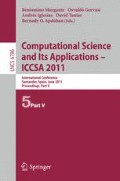Abstract
Wireless Sensor Networks (WSNs) consist of a large number of low powered nodes that need to operate for months unattended. Since modern WSNs are used in various applications, their topology is becoming complicated. Due to limited precision of deployment, holes may occur in the network, which often lead traditional Greedy Forwarding algorithms to fail. Thus, bypassing the holes is one of the important issues for WSNs. Since each node has limited energy, its energy consumption needs to be optimized to prolong network lifetime. In the well-known Virtual Position (ViP) scheme, each node routes data using virtual positions instead of actual geographic positions to improve the packet delivery rate. A Hole-bypassing Routing with Context-awareness scheme achieves balanced energy consumption by changing current path to one of the candidate paths, based on the residual energy of nodes. However, this scheme tends to extend the size of holes. Since existing hole detour schemes that do not consider efficient energy consumption, they cause imbalanced energy consumption and make network lifetime relatively shorter than other hole detour schemes. Similar to ViP, our scheme uses virtual positions to bypass holes. However, the virtual positions are computed using both geographic positions and the residual energies of neighbor nodes. Our approach outperforms the ViP scheme in terms of network lifetime and hole extension.
Corresponding author.
Access this chapter
Tax calculation will be finalised at checkout
Purchases are for personal use only
Preview
Unable to display preview. Download preview PDF.
References
Finn, G.G.: Routing and addressing problems in large metropolitan-scale internetworks. Technical Report ISI/RR-87-180, Information Sciences Institute (1987)
Warneke, B., Last, M., Liebowitz, B., Kristofer, Pister, S.J.: Smart Dust: Communicating with a Cubic-Millimeter Computer. Computer Magazine 34(1), 44–51 (2001)
Ahmed, N., Kanhere, S.S., Jha, S.: The hole problem in wireless sensor networks: a survey. ACM SIGMOBILE Mobile Computing and Communications Review 9(2) (2005)
You, J., Lieckfeldt, D., Han, Q., Salzmann, J., Timmermann, D.: Look-ahead Geographic Routing for Sensor Networks. In: Proceedings of PERCOM (2009)
Karp, B., Kung, H.T.: GPSR: Greedy perimeter stateless routing for wireless networks. In: Proceedings of MobiCom, pp. 243–254 (2000)
Jia, W., Wang, T., Wang, G., Guo, M.: Hole Avoiding in Advance Routing in Wireless Sensor Networks. In: Proceedings of IEEE WCNC (2007)
You, J., Lieckfeldt, D., Reichenbach, F., Timmermann, D.: Context-aware Geographic Routing for Sensor Networks with Routing Holes. In: Proceedings of IEEE WCNC (2009)
Sheng, X., Hu, Y.: Maximum Likelihood Multiple-Source Localization Using Acoustic Energy Measurements with Wireless Sensor Networks. IEEE Transactions on Signal Processing 53(1) (2005)
Niu, R., Varshney, K.: Target Location Estimation in Sensor Networks with Quantized Data. IEEE Transactions on Signal Processing 54(12) (2006)
Zhu, J., Chen, S., Bensaou, B., Hung, K.-L.: Tradeoff between lifetime and rate allocation in wireless sensor networks: a cross layer approach. In: Proceedings of IEEE INFOCOM (2007)
Texas Intruments. 2.4 GHz IEEE 802.15.4 / ZigBee-Ready RF Transceiver, Rev. B (2007), http://focus.ti.com/docs/prod/folders/print/cc2420.html
Tang, J., Xue, G.: Node-disjoint path routing in wireless networks: tradeoff between path lifetime and total energy. In: Proceedings of IEEE ICC, pp. 3812–3816 (2004)
Maleki, M., Dantu, K., Pedram, M.: Lifetime prediction routing in mobile ad hoc networks. In: Proceedings of IEEE WCNC (2003)
Xu, Y., Heidemann, J.S., Estrin, D.: Geography-informed energy conservation for ad hoc routing. In: Proceedings of MOBICOM, pp. 70–84 (2001)
Author information
Authors and Affiliations
Editor information
Editors and Affiliations
Rights and permissions
Copyright information
© 2011 Springer-Verlag Berlin Heidelberg
About this paper
Cite this paper
Son, Z., Cha, M., Shon, M.H., Kim, M., Kim, M., Choo, H. (2011). A Hole Detour Scheme Using Virtual Position Based on Residual Energy for Wireless Sensor Networks. In: Murgante, B., Gervasi, O., Iglesias, A., Taniar, D., Apduhan, B.O. (eds) Computational Science and Its Applications - ICCSA 2011. ICCSA 2011. Lecture Notes in Computer Science, vol 6786. Springer, Berlin, Heidelberg. https://doi.org/10.1007/978-3-642-21934-4_17
Download citation
DOI: https://doi.org/10.1007/978-3-642-21934-4_17
Publisher Name: Springer, Berlin, Heidelberg
Print ISBN: 978-3-642-21933-7
Online ISBN: 978-3-642-21934-4
eBook Packages: Computer ScienceComputer Science (R0)

